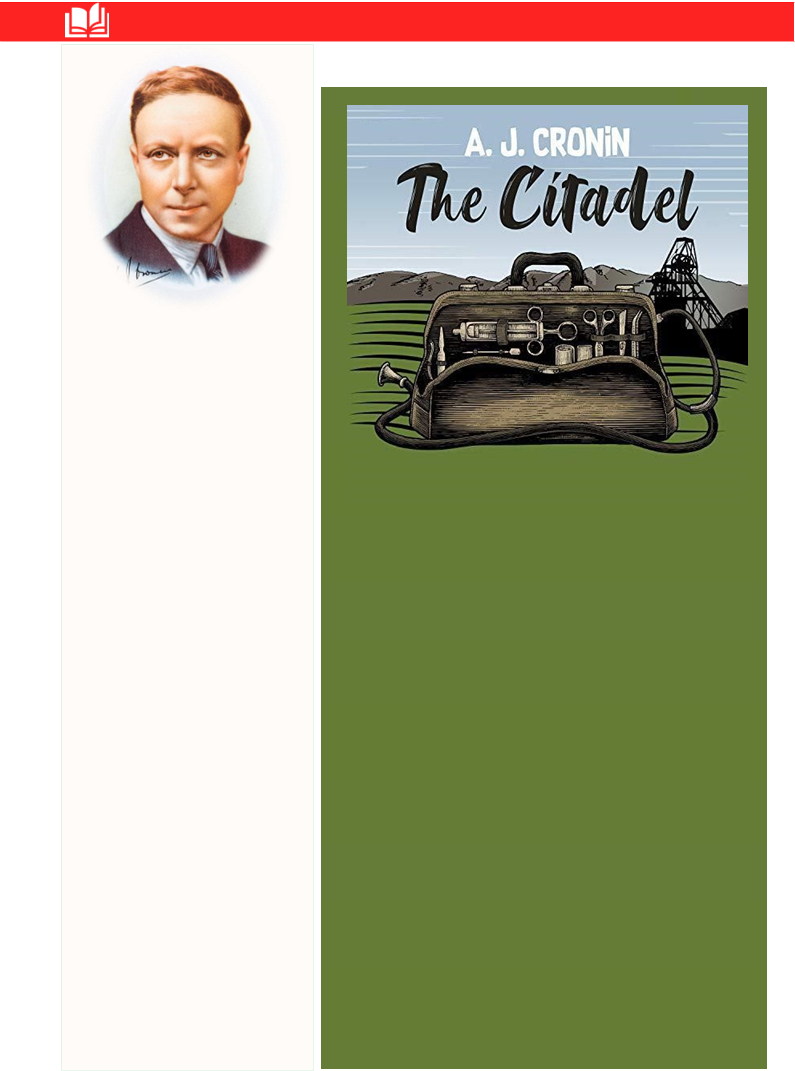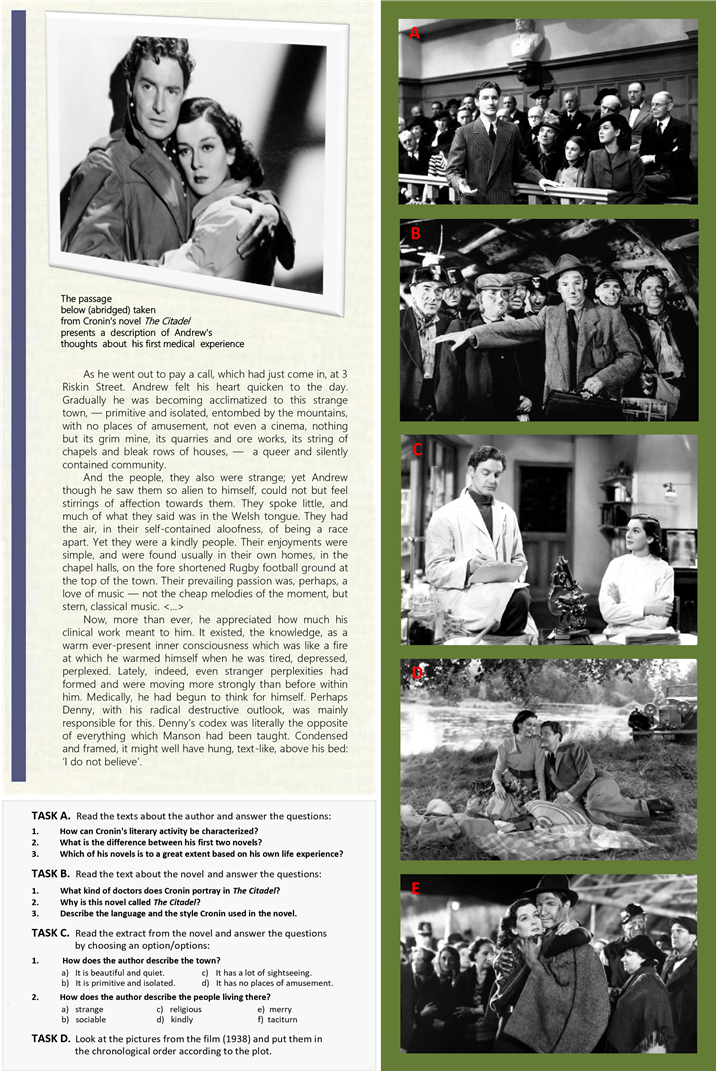Робочий аркуш (a worksheet): "The Citadel by Archibald Cronin"
Спецкурс з Літератури Великої Британії для учнів 10-11 класів
Тема: Література першої половини XX ст.
English Literature
THE CITADEL by ARCHIBALD CRONIN
ABOUT THE AUTHOR
Archibald Cronin, in full Archibald Joseph Cronin (1896—1981) is a Scottish novelist and physician whose works combining realism with social criticism won a large Anglo-American readership.
A. Gronin was born in Scotland in a worker's family. His sympathy for working class people was later reflected in his works. At school he took a great interest in literature. At the age of thirteen he won a gold medal in a nation-wide competition for the best historical essay of the year But his love for natural sciences got the upper hand and in 1914 he began to study medicine at Glasgow University His studies were interrupted by service in the Navy After the war, in 1919, he graduated from the University. In 1921 he began his medical practice in South Wales where he came to know well the hard life and work of coal-miners. In 1923 he was appointed Medical Inspector of mines and a year later was awarded the degree of M. D. with Honours by Glasgow University.
The publication of the novel Hatter’s Castle (1931) marked the beginning of Cronin's fruitful literary career. The novel tells the readers about a family which is gradually being destroyed by the despotism and ambitions of Mr Brodie, the father Yet, the author neither analyses the social reasons for the appearance of such people as Brodie, nor does he show anything of what he feels towards the characters and events depicted in his novel.
His book The Stars Look Down (1935) presents an entirely different approach to reality Cronin shows the relations between the miners and their masters . The major conflict in the book is, as Cronin puts it, a social struggle that arises from the clash of ‘two na tions’. The author's satire is directed against the ruling classes. The injustice of the existing order, the social con traditions are effectively exposed in the novel. Cronin also realistically depicts the hard struggle which the miners carry on against the pit-owners. David, the main character of the novel, cannot be called a revolutionary, but his passionate love for people and his desire for justice make him one of the best characters in the critical realism of the 1930 s.
World War II caused changes in Cronin’s literary activities. He left for America and in his further work he dealt less and less with burning social problems. His latest novels The Keys of the Kingdom (1941), The Green Years (1944), Shannon’s Way (1948), A Song of Sixpence (1965),
A Pocketful of Rye (1967) are not as critical as his works of the 1930s.
ABOUT THE NOVEL
In 1937 Cronin published The Citadel, a fine collection of portraits of the English medical world. The action in the novel begins in 1924 and ends in the middle of the 1930s. It is a novel which has not only an interesting plot but also fascinates the reader with its realism and vivid portrayal of characters. Cronin shows how difficult it is to be honest and principled. The main character of the novel is Andrew Manson who after graduating from
the university starts working as a general practitioner in a small town in South Wales. The first steps are always hard, they are especially hard for Andrew who has to work on his own, for Dr. Page whose assistant Andrew is, does not practise at all because of his illness. Hard work is no burden for Andrew but he lacks experience, he can't even diagnose his first case. Luckily Andrew gets acquainted with Doctor Philip Denny who helps him a lot. When there is an outbreak of typhoid Andrew is at a loss, for he sees no way to fight it. Philip Denny suggests blowing up an old sewer which causes infection. The blowing up of the sewer is one of the best scenes of the novel. Besides hardships and difficulties, however, Andrew meets love and affection. He gets acquainted with an attractive and gentle young teacher, Christine Barlow. They fall in love and get married. Andrew undertakes a research on miners' lung diseases, and successfully passes the M.R.S. P examinations. But soon he has to leave for London, having been wrongly accused of vivi
 section. There Andrew, determined to make a career, is unaware that he gradually loses his best qualities as a man and as a scientist. Cronin gives a thorough description of Andrew's moral decline: first, money becomes most important to him, and then he loses interest in work and scientific research. All this cannot but affect his relations with Christine, who sees what is happening and tries to prevent his degra dation. However, honesty prevails in Manson's nature; seeing a patient die one day because of the negligence and stupidity of some doctors, he is born anew. He becomes the Andrew of his early days in South Wales again. But suddenly disaster strikes: Christine is killed in a road accident. The blow is a heavy one, Andrew suffers acutely, but after the catastrophe he begins to see and understand many things. Very realistically the author gives a panorama of medical life, showing the position of English doctors and medical personnel. Cronin portrays a whole gallery of different doctors: those who give all their heart and knowledge to people, and those who make their fortunes at the cost of other people's tragedies. We are given portraits of idealistic doctors, such as Denny, Hope and others and, side by side with them, the money-grabbing doctors Freddy Hampton, Ivory and Freedman. Cronin's greatest merit as an artist is that his characters are typical. The psychological depth of his portrayal makes them come to life. The language is not complicated. There are not many descriptions in it, but it abounds in dialogues. Cronin created highly individualized and memorable speech portraits. The chief feature of his style is simplicity and accuracy.
section. There Andrew, determined to make a career, is unaware that he gradually loses his best qualities as a man and as a scientist. Cronin gives a thorough description of Andrew's moral decline: first, money becomes most important to him, and then he loses interest in work and scientific research. All this cannot but affect his relations with Christine, who sees what is happening and tries to prevent his degra dation. However, honesty prevails in Manson's nature; seeing a patient die one day because of the negligence and stupidity of some doctors, he is born anew. He becomes the Andrew of his early days in South Wales again. But suddenly disaster strikes: Christine is killed in a road accident. The blow is a heavy one, Andrew suffers acutely, but after the catastrophe he begins to see and understand many things. Very realistically the author gives a panorama of medical life, showing the position of English doctors and medical personnel. Cronin portrays a whole gallery of different doctors: those who give all their heart and knowledge to people, and those who make their fortunes at the cost of other people's tragedies. We are given portraits of idealistic doctors, such as Denny, Hope and others and, side by side with them, the money-grabbing doctors Freddy Hampton, Ivory and Freedman. Cronin's greatest merit as an artist is that his characters are typical. The psychological depth of his portrayal makes them come to life. The language is not complicated. There are not many descriptions in it, but it abounds in dialogues. Cronin created highly individualized and memorable speech portraits. The chief feature of his style is simplicity and accuracy.



про публікацію авторської розробки
Додати розробку
